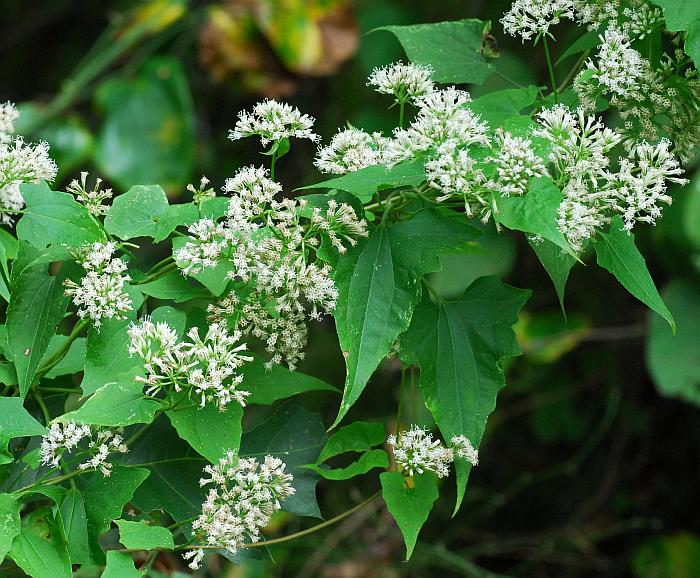Mikania scandens (L.) Willd.
Climbing Hempweed

Native
CC = 5
CW = -5
MOC = 8
© SRTurner
Mikania scandens (L.) Willd.Climbing Hempweed | |
 |
Native CC = 5 CW = -5 MOC = 8 |
© SRTurner |
|
Family - Asteraceae/Eupatorieae Habit - Perennial twining forbs with fleshy root clusters. Stem - Prostrate or climbing in other vegetation, to 5 m, glabrous to densely and minutely hairy, often sparsely glandular.
Leaves - Opposite, simple, long-petiolate. Blades 2-12 cm long, triangular to triangular-ovate, truncate to cordate at the base, tapered to a sharply pointed tip, often with a pair of short, bluntly triangular, spreading basal lobes, the margins otherwise entire to somewhat wavy, scalloped or bluntly toothed, the surfaces sparsely to moderately pubescent with short, curved hairs, also sparsely to moderately glandular, the main veins palmate.
Inflorescence - Inflorescences axillary panicles or stalked clusters, dome-shaped, often numerous.
Heads - Heads discoid, with 4 florets. Involucre 4-6 mm long, more or less cylindrical. Involucral bracts 4 (the head often also subtended by 1 or 2 other shorter bracts), more or less equal in size, narrowly oblong-elliptic to narrowly elliptic-lanceolate, tapered to a sharply pointed tip, glabrous or sparsely to moderately and finely short-hairy. Receptacle flat or nearly so.
Florets - Corollas white to pale pink or rarely pale lavender, glandular. Pappus of numerous capillary bristles.
Fruits - Fruits 1.5-2.5 mm long, 5-angled, somewhat wedge-shaped to nearly linear, densely glandular, dark brown to black.
Flowering - July - October. Habitat - Swamps, bottomland forests, sloughs, pond margins, ditches, levees. Origin - Native to the U.S. Lookalikes - Cynanchum laeve. Other info. - This vining species can be found in the southeast corner of Missouri. Its U.S. distribution also includes most of the South and eastern seaboard. The plant is very easy to identify in the field because of its vining habit, opposite leaves with basal lobes, and umbels of whitish flower heads. The inflorescences are sweetly fragrant when at anthesis. This species can grow very long very quickly and is probably not the best choice to plant around a water garden. The plant is, however, frequently visited by many different types of flying insects. Photographs taken at Mingo NWR, Stoddard County, MO, 9-20-2019 (SRTurner). |